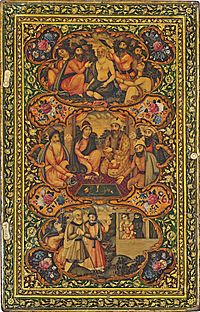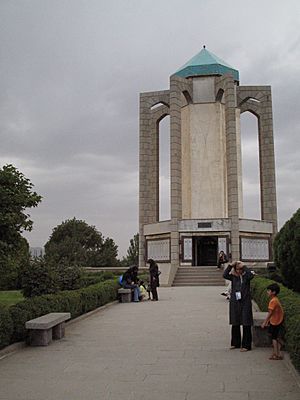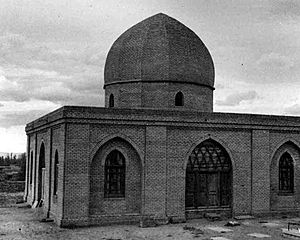Baba Tahir facts for kids
Quick facts for kids Baba Tahir of Hamedan |
|
|---|---|

Cover from a lacquer mirror case with multiple scenes, school of Mohammad Esmail Esfahani; the top scene depicts Baba Tahir with disciples. Created in Qajar Iran, dated c. 1855-60
|
|
| Mystic Poet | |
| Born | c. 11th century Hamadan, Iran |
| Died | c. 11th century Hamadan, Iran |
| Venerated in | Islam |
| Major shrine | Hamadan, Iran |
| Influences | Ferdowsi, Sanai, Khwaja Abdullah Ansari, Mansur Al-Hallaj, Abu-Sa'id Abul-Khayr, Bayazid Bastami |
| Influenced | Rumi, Hafez, Jami, Omar Khayyam, Nizami Ganjavi, and many other later mystic poets |
|
Tradition or genre
|
Mystic poetry |
Baba Tahir or Baba Taher Oryan Hamadani (Persian: باباطاهر عریان همدانی) was an important dervish poet from Hamadan, Iran. He lived around the 11th century, during the time of the Seljuk Empire. Not much is known about his life because he lived in a very private and mysterious way.
The name "Baba" means 'The Wise' or 'The Respected'. His nickname "Oryan" means 'The Naked'. This nickname probably came about because he lived a very spiritual life. He did not care much for worldly things or material possessions. His poems are written in a special dialect of the Persian language from Hamadan.
Contents
Who Was Baba Tahir?
Baba Tahir is known as one of the most respected early poets in Persian literature. He was born into a Persian family in Hamadan Province, Iran. The name Baba Taher-e Oryan (The Naked) suggests he might have been a wandering dervish. Dervishes are people who follow a spiritual path in Islam.
The exact dates of his birth and death are not known for sure. Some sources say he died around 1019. If this is true, he would have lived around the same time as famous poets like Ferdowsi. It is also believed that Baba Tahir lived for about 75 years. During the 10th century when he lived, art and literature were growing a lot in Persia. Artists and poets were highly valued and could express their ideas freely.
Baba Tahir's Poetry
Baba Tahir's poems are still recited today across Iran. They are often sung along with the setar, which is a type of stringed instrument. This style of poetry is very old and is called Pahlaviat.
Many of his poems are in a style called do-baytī. This is a form of Persian quatrains, which are poems with four lines. His quatrains are mostly about love and spiritual feelings. They are less about philosophy.
Baba Tahir's Writings
Baba Tahir is also believed to have written a book called Kalemat-e Qesaar. This book is a collection of almost 400 short, wise sayings in Arabic. These sayings connect knowledge with spiritual understanding.
For example, one of his sayings explains that "Knowledge guides you to spiritual understanding." He also said, "Knowledge is like a crown for someone who understands God." These sayings show his deep spiritual thoughts.
Where is Baba Tahir's Tomb?
Baba Tahir's tomb is located in a park in Hamadan, Iran. The park is filled with flowers and winding paths. The tomb was designed by Mohsen Foroughi and built in 1970. It has twelve pillars around a central tower. It is a beautiful and peaceful place.
See also
 In Spanish: Baba Taher para niños
In Spanish: Baba Taher para niños
- Mir Sayyid Ali Hamadani
- Ahmad NikTalab
- Persian literature



